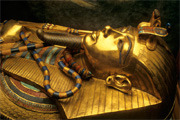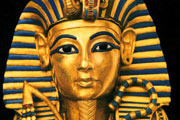When you hear about a Mummy do you think about some stiff-legged, skeleton wrapped in loose cloth trying to seek revenge? Or maybe you think of young King Tut laid out in his golden tomb. Whatever the case, these shriveled, icky looking bodies go back a long way.
What is a Mummy?
A mummy is a very old, dead body. It's not a skeleton or a fossil cuz some soft tissue (skin, organs and muscles) is still stuck on the bones. This mummification can happen on purpose or by accident. Some of the world's best-known mummies were accidentally created when a body was put in a place where no air or moisture could get to it. Lack of air and moisture delays the decaying process and mummifies the body. Bodies can be dried in the sun, with fire or smoke, or by freezing it.
Master Mummy Makers
Egyptians weren't the first or the last to create mummies but they were probably the best known for them. This might have more to do with their very hot climate than their skill. Desert winds and scorching hot sand would quickly dry out a dead body. In fact, one of the oldest Egyptian mummies (from about 3500 B.C). might have been created this way. Back then, if you wanted your body mummified by the pros it would have cost an arm and a leg, or your weight in gold.
How to Make a Mummy - Step One
It takes 70 days to make a well preserved mummy. First, internal parts of the body have to be removed. Take a special hooked tool - it looks like a crochet needle - and carefully put it up the nose and scoop out brain tissue. Then make a cut on the left side of the stomach and remove stomach and chest organs. The heart stays where it is but the stomach, liver, lungs and intestines are put in special boxes or jars, known as canopic jars. These jars go in the tomb with the body.
How to Make a Mummy - Step Two
Next, all the moisture must be taken out of the body. Cover the body with natron, a salt that works great for this process, and put natron packets inside the body. When the body is dried out completely, remove all the natron. The body will look like a blackened dried out human. Fill sunken parts of the body with linen and add false eyes.
How to Make a Mummy - Step Three
Now it's time to wrap the body. You'll need about 150 yards of linen - the length of one and a half football fields. Use long strips of the linen to carefully wrap the body. This might take up to 15 days. Fingers and toes can be wrapped individually, but they don't have to be. In between layers put warm sticky stuff like pitch or tree sap on the linen. You might also want to add good luck charms and jewelry. When this is done, the mummy is complete.
The Afterlife
Egyptians believed that mummifying a person's body after he or she died was an important part of a person's safe passage to the afterlife. The tomb was also prepared for this journey. Furniture, food, wall paintings, statues and, of course, jewelry were buried with the body. A mask was put over the face so the soul would recognize the body when it returned to Earth. Between the fourth and seventh century A.D. many Egyptians became Christians so they stopped making mummies. During the 3000 year mummy-making period it is thought that more than 70 million mummies were made in Egypt. Thanks to vandals, grave robbers and treasure hunters, most of them will never be found.

































